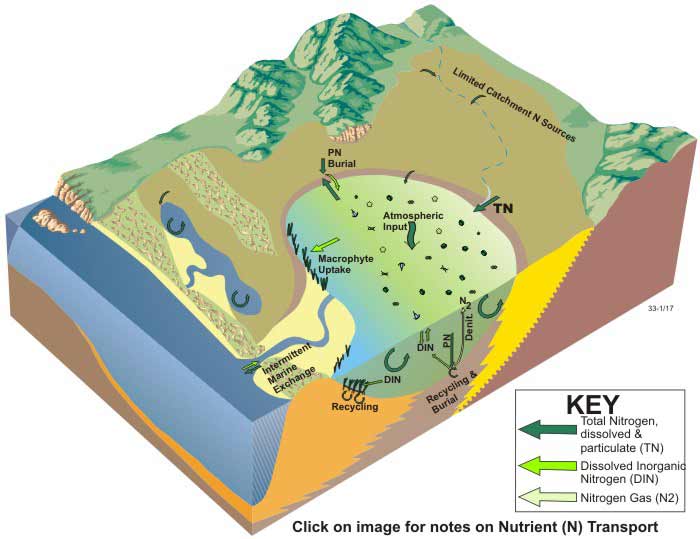
Nitrogen dynamic processes in coastal lagoons and strandplains
1. Limited catchment of nitrogen sources
Catchment-derived sources of nitrogen are less important in coastal lagoons and strandplain-associated creeks – significant input typically occurs during extreme rainfall events only. Groundwater inputs, and input of particulate N (PN) from atmospheric sources such as smoke and ash is significant (Harris, 2001).
2. Uptake and processing of nitrogen by phytoplankton
Any nitrogen entering the lagoon is typically processed mostly by phytoplankton, if temperature and light levels are suitable (Gaughan et al., 1995, Webster et al., 1998). Long residence times (during barrier closure) ensure that processing of dissolved inorganic nitrogen is complete. Coastal lagoons and strand plain-associated coastal creeks that are open to the ocean can intermittently undergo dramatic changes in their physical and chemical parameters over short periods, owing to their dynamic connection to the sea (e.g. Pollard, 1994, Griffiths, 2001).
3. Deposition and burial in saltmarshes
Some deposition and burial of particulate nitrogen (PN) occurs on flanking environments, due to the baffling effects of saltmarsh vegetation. Burial and resuspension of PN and dissolved inorganic nitrogen (DIN) can also occur within intertidal flats.
4. Phytoplankton debris
PN is deposited in the sediment as phytoplankton debris. Typically, coastal lagoons experience a large degree of nutrient recycling in comparison to catchment inputs. Large reserves of nutrients are often held in the form of dense stands of micro- and macroalgae growing on the bed and in the water column of the lagoon (Webster et al., 2002).
5. Resuspension of particulate nitrogen
Decomposition of organic matter within the sediment produces dissolved inorganic nitrogen (potentially available for further plant/phytoplankton growth). Denitrification within the sediment converts some nitrate (NO32-) to N2 gas, which escapes from the system to the atmosphere (Heggie et al., 1999a, Usui et al., 2001). A small proportion of the particulate nitrogen (PN) deposited into the sediment is buried, although due to the shallow nature of these systems, resuspension is common.
6. Uptake of water column nitrogen by seagrasses
Seagrasses, if present, take up dissolved inorganic nitrogen (DIN) from the water column, and from the sediment pore-waters. Higher nutrient concentrations may limit seagrass growth due to increased turbidity from phytoplankton and epiphyte growth (Moriarty et al., 1985, Pollard et al., 1993).The pore-water dissolved inorganic nitrogen (DIN) is derived from the metabolism of phytoplankton, seagrass and other organic matter debris. The seagrass debris therefore, in part, is “recycled” back to the plants (Moriarty et al., 1985). N-fixation (incorporation of atmospheric N2 to form nitrogenous organic compounds) occurring in the root-zone may also contribute additional dissolved inorganic nitrogen (DIN) to this pool (Pollard et al., 1991).
7. Limited exchange with the marine environment
Very small quantities of the total nitrogen (TN) load are exported to the marine environment only during periods of open entrance conditions. Export is more significant during flood events. Due to limited marine flushing, coastal lagoons and strandplain-associated creeks may be highly susceptible to increased nutrient input.


